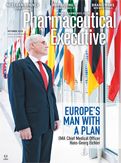Biosimilars, Patent Issues Dominate Political Landscape
Pharmaceutical Executive
Managing the nomination of new FDA commissioner adds to packed agenda
After months of legal wrangling, Novartis’ Zarxio finally hit the US market in September, setting the stage for the first real test of how biosimilars will affect pharmaceutical prescribing, competition and costs. This follow-on to Amgen’s Neupogen (filgrastim) is the first
Jill Wechsler

biosimilar approved in the US, but there’s a wave of similar products in the pipeline. The pace of change, though, assumes resolution of a number of contentious issues, including names and labels for biosimilars and what additional testing is required for interchangeability. Continued dispute over the “patent dance” established by the Biologics Price Competition & Innovation Act (BPCIA) remains a potential roadblock to biosimilar marketing, as occurred with Zarxio since its approval last March.
The stated goal for regulators and biosimilar makers is to facilitate patient access to needed medicines at affordable prices, and all parties will be seeking signs of where savings might fall-predictions have ranged from $5 billion to $100 billion over 10 years. Sandoz launched Zarxio with a price 15% below Amgen’s brand-much less of a discount than anticipated by pharmacy benefit managers (PBMs) and payers, but with expectations that the price will drop as more filgrastim follow-ons arrive.
Names & codes
Key to biosimilar uptake is the scope of indications in the approved label and whether follow-ons have distinctive names and payment codes. FDA issued a proposal in August addressing naming issues, which has only heightened the debate. Biosimilar advocates want follow-ons to carry the same proprietary names as reference drugs to encourage prescribing and reimbursement; brand companies claim that different names are necessary to prevent inadvertent substitution and confusion tracking adverse events.
FDA’s guidance (posted August 27 at fda.gov.) appears to lean towards the “ensure safety” camp by calling for all biotech therapies to carry a unique, four-digit suffix in addition to a “core” name. This approach mirrors the agency’s decision to assign Zarxio the name filgrastim-sndz as a placeholder. The agency says it can’t rely on NDC drug codes for product identification and tracking because most biologics are administered in clinics and doctors’ offices, and that this strategy will permit a manufacturer to market more than one version of a biosimilar.
While innovators may support using suffixes to differentiate biosimilars from reference products, they are up in arms over the agency’s related proposal to add suffixes to all biotech therapies, including those already on the market. To start the difficult renaming process, FDA also issued a proposed rule that specifically applies the new naming policy to six licensed biologics facing near-term competition from biosimilars (see Federal Register, vol. 80, no. 167, August 28, 2015). Requiring new names for old products has never occurred before, says Gillian Woollett of Avalere Health, noting that significant database and software changes may be needed to accommodate the change. And it may be difficult to identify renamed drugs in the scientific literature, observes Emily Alexander, director of US regulatory affairs at AbbVie.
Also unclear is how FDA will apply the new naming policy to biosimilars that achieve interchangeable status. One option is to permit the same suffixes for brands and interchangeables, something that FDA will consider as it weighs what are sure to be voluminous comments on its these proposals.
In addition to biosimilar naming, health plan coding is critical for determining product coverage and reimbursement. Here, Medicare officials have stirred up a tempest with a proposal issued in July to assign common J-codes for all biosimilars to a reference product reimbursed under Medicare Part B. This approach has generated heated opposition from biosimilar makers, as well as patient groups and members of Congress, who complain it will create confusion, especially for biosimilars with different indications.
Lawmakers are concerned that FDA’s slow pace in resolving these and other issues is delaying biosimilar development and prescribing, as discussed at a September hearing before the Senate Health committee.

Janet Woodcock, director of the Center for Drug Evaluation and Research (CDER), described the agency’s challenges in issuing and finalizing guidances, assuring the legislators that her staff is hard at work crafting policies on labeling, analytical assessment, and interchangeability. She also noted the pressure on FDA resources to educate prescribers and patients on biosimilar prescribing, as well as the multiple meetings and assistance involved in evaluating nearly 60 biosimilars in development.
Patent protections
Although the Court ruled Sept. 3 that Sandoz could begin marketing Zarxio, it did not settle the larger issues on whether the a 180-day notification period to the reference product maker is optional under the BPCIA (as Sandoz claims) or mandatory (Amgen’s view). Both companies have requested full-court rehearings of these and related issues, and final resolution could end up before the Supreme Court.
Patent disputes over biosimilars are just one area of contention involving biopharma intellectual property protection. The Obama administration has objected to the current 12 years of market exclusivity awarded innovator biotherapies, a policy that has ignited controversy in negotiations over the Trans-Pacific Partnership (TPP) trade deal.
The most high-profile IP contest involves the inter partes review (IPR) process at the US Patent and Trademark Office (USPTO). Established by Congress in 2011 to quickly resolve disputes over low-quality patents, it has opened the door to “predator” challenges to patents on drugs and biotech therapies, notably by hedge-fund manager Kyle Bass. His Coalition for Affordable Drugs is attacking patents he claims allow pharma companies to maintain high prices and unjust profits; biotech companies counter that Bass is a new type of “patent troll” who seeks financial gain by shorting the stock of companies under attack.
Industry is lobbying for new patent legislation that exempts biopharma companies from the IPR process, but the Congressional Budget Office calculated that such a change would cost the government $1.3 billion over 10 years by delaying competition from generics and biosimilars. Meanwhile, drug and biotech companies are turning to the IPR process themselves to challenge competitors’ patents, including makers of generic drugs and biosimilars seeking to invalidate innovator patents quickly.
Jill Wechsler is Pharmaceutical Executive's Washington correspondent. She can be reached at jwechsler@advanstar.com

Pfizer, GSK Gain ACIP Recommendations for RSV and Meningococcal Vaccines
April 18th 2025The Centers for Disease Control and Prevention’s Advisory Committee on Immunization Practices voted to expand access to Pfizer’s respiratory syncytial virus vaccine Abrysvo for high-risk adults in their 50s and voted in favor of GSK’s meningococcal vaccine, Penmenvy, for streamlined adolescent protection.
Navigating Distrust: Pharma in the Age of Social Media
February 18th 2025Ian Baer, Founder and CEO of Sooth, discusses how the growing distrust in social media will impact industry marketing strategies and the relationships between pharmaceutical companies and the patients they aim to serve. He also explains dark social, how to combat misinformation, closing the trust gap, and more.